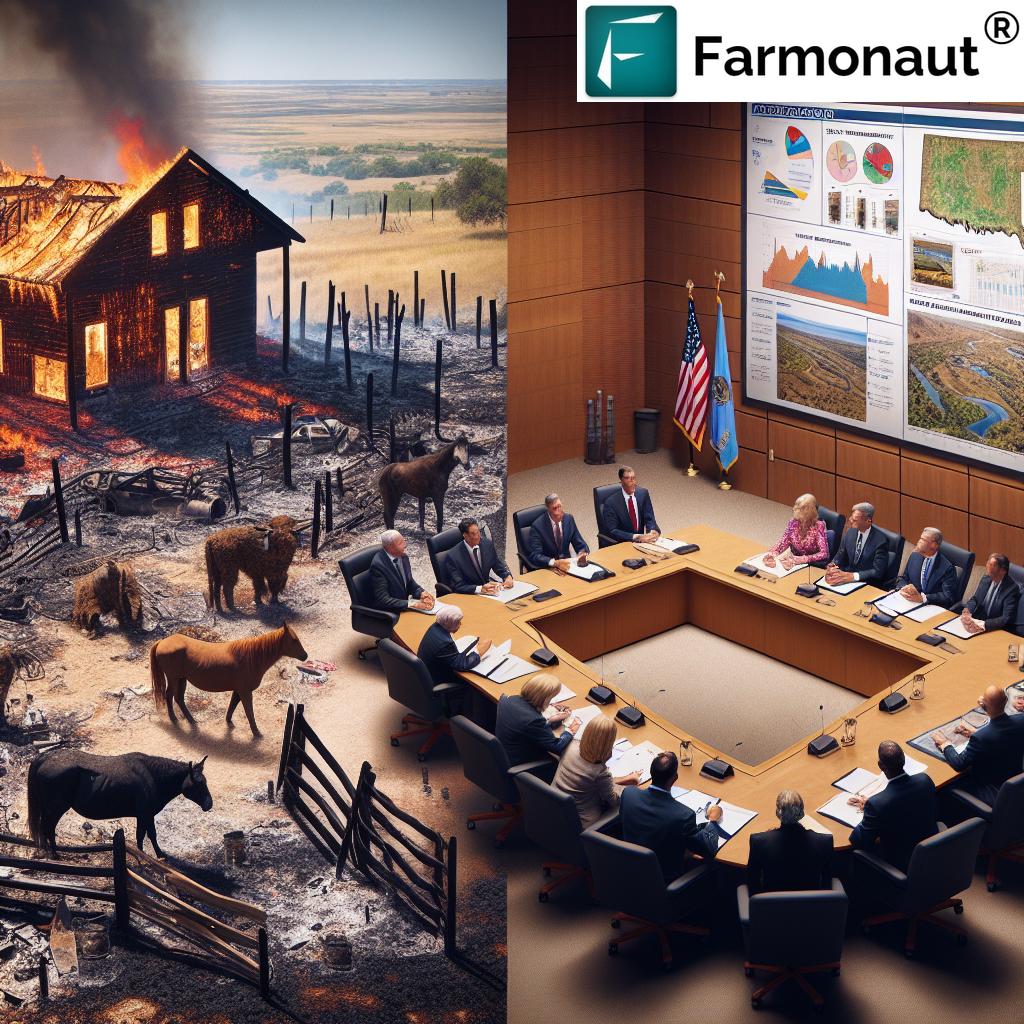Oklahoma Wildfire Crisis: State Forestry Leadership Changes Amid Devastating Fire Damage and Response Challenges
“Oklahoma wildfires burned thousands of acres and destroyed hundreds of homes in a recent devastating crisis.”
In recent weeks, Oklahoma has faced one of its most challenging wildfire crises in recent memory. The devastation wrought by these fires has not only scarred the landscape but also prompted significant changes in the state’s forestry leadership and wildfire response strategies. As we delve into this pressing issue, we’ll explore the impact of these wildfires on Oklahoma’s agriculture and forestry sectors, the challenges faced by officials in managing such catastrophic events, and the steps being taken to enhance the state’s preparedness for future fire seasons.
The Scope of the Oklahoma Wildfire Crisis
The recent wildfires that swept through Oklahoma have left a trail of destruction in their wake. Starting on March 14th and lasting for nearly a week, these fires burned thousands of acres across the state, destroying hundreds of homes and tragically claiming four lives. The scale of this disaster has forced a reassessment of Oklahoma’s wildfire prevention strategies and response capabilities.

The impact of these wildfires extends far beyond the immediate destruction of property. The agricultural sector, a cornerstone of Oklahoma’s economy, has been severely affected. Farmers and ranchers are now grappling with the loss of livestock, crops, and critical infrastructure. The long-term ecological consequences of such extensive burning are yet to be fully understood, but they are likely to be significant.
Leadership Changes in the Wake of Crisis
In the aftermath of this devastating event, significant changes have occurred within Oklahoma’s forestry leadership. Mark Goeller, who had served as the State Forester and Director of the Oklahoma Department of Agriculture, Food and Forestry’s Forestry Services Division since 2018, is now unemployed. This sudden change comes after nearly four decades of service with the Oklahoma Forestry Service.
Governor Kevin Stitt expressed his dissatisfaction with the handling of the recent wildfires in a press conference, stating, “We had a horrible, horrible wildfire in the state of Oklahoma. I didn’t think they did a really good job.” This statement underscores the gravity of the situation and the high stakes involved in effective wildfire management.
Challenges in Wildfire Response and Suppression
The Oklahoma Forestry Service, which leads the state’s response to wildfire suppression, faced unprecedented challenges during this crisis. The scale and intensity of the fires tested the limits of the state’s resources and response strategies. Some of the key challenges included:
- Rapid spread of fires due to dry conditions and strong winds
- Difficulty in coordinating resources across multiple affected areas
- Limitations in manpower and equipment for large-scale fire suppression
- Challenges in protecting remote and rural properties
These challenges highlight the need for a comprehensive review and enhancement of Oklahoma’s wildfire suppression techniques and overall state forest fire management strategies.
The Role of Technology in Wildfire Management
As we look towards improving Oklahoma’s wildfire response, technology plays a crucial role. Advanced systems like those offered by Farmonaut can significantly enhance our ability to monitor and respond to wildfires. For instance, Farmonaut’s satellite-based monitoring systems could potentially be adapted for early detection of wildfire outbreaks.
While Farmonaut primarily focuses on agricultural applications, its carbon footprinting technology could be valuable in assessing the environmental impact of wildfires. This tool could help quantify the carbon emissions from large-scale fires, aiding in both immediate response planning and long-term environmental management strategies.
Improving Wildfire Prevention Strategies
In light of the recent crisis, there’s a pressing need to reevaluate and enhance Oklahoma’s wildfire prevention strategies. Some key areas of focus include:
- Enhanced Monitoring Systems: Implementing advanced satellite and AI-based monitoring systems to detect potential fire hazards early.
- Improved Land Management: Developing more effective strategies for managing vegetation and creating firebreaks in high-risk areas.
- Public Education and Awareness: Increasing efforts to educate the public about fire safety and prevention measures, especially in rural and forested areas.
- Resource Allocation: Ensuring that firefighting resources are strategically positioned and readily available in high-risk regions.
“The Oklahoma Department of Agriculture, Food and Forestry’s Forestry Services Division is undergoing leadership changes due to wildfire response challenges.”
The Impact on Agriculture and Forestry
The wildfires have had a significant impact on Oklahoma’s agriculture and forestry sectors. Farmers and ranchers are facing immediate challenges such as loss of livestock, damage to crops, and destruction of farm infrastructure. The long-term effects on soil health and forest ecosystems are also a major concern.
In addressing these challenges, technologies like Farmonaut’s crop plantation and forest advisory services could prove invaluable. These tools can help farmers and foresters assess damage, plan recovery efforts, and make informed decisions about replanting and land management in the aftermath of wildfires.

Economic Implications of the Wildfire Crisis
The economic impact of the Oklahoma wildfires extends far beyond the immediate destruction of property. The state is now facing significant challenges in terms of:
- Agricultural losses, including crops and livestock
- Damage to infrastructure, including homes, businesses, and public facilities
- Increased costs for fire suppression and emergency response
- Potential long-term effects on tourism and local economies in affected areas
To address these economic challenges, innovative solutions are needed. For instance, Farmonaut’s crop loan and insurance services could play a crucial role in helping farmers recover financially from wildfire damage. By providing accurate, satellite-based assessments of crop damage, these services can streamline the process of insurance claims and loan applications for affected farmers.
Environmental Consequences and Recovery
The environmental impact of the Oklahoma wildfires is profound and multifaceted. Key concerns include:
- Loss of wildlife habitat
- Soil erosion and potential water quality issues
- Changes in local ecosystems and biodiversity
- Increased carbon emissions contributing to climate change
Addressing these environmental challenges requires a comprehensive approach. Technologies like those offered by Farmonaut can aid in the recovery process. For example, their satellite-based vegetation monitoring could be used to track the regrowth of burned areas and assess the effectiveness of reforestation efforts.
The Future of Wildfire Management in Oklahoma
As Oklahoma moves forward from this crisis, there’s a clear need for a comprehensive overhaul of the state’s approach to wildfire management. This includes:
- Enhanced Early Warning Systems: Implementing advanced technologies for early detection and prediction of wildfire risks.
- Improved Coordination: Enhancing cooperation between state, local, and federal agencies for more effective fire response.
- Investment in Resources: Allocating more resources to firefighting equipment, personnel training, and prevention measures.
- Adaptive Land Management: Developing more resilient land management practices that take into account changing climate conditions.
In this context, technologies like Farmonaut’s large-scale farm management solutions could be adapted to assist in managing large areas of forest and grassland. These tools could help in monitoring vegetation health, identifying high-risk areas, and planning controlled burns to reduce wildfire risks.
Community Involvement and Education
A crucial aspect of improving Oklahoma’s wildfire preparedness is enhancing community involvement and education. This includes:
- Public awareness campaigns about fire safety and prevention
- Training programs for local communities in basic firefighting and emergency response
- Encouraging community-led initiatives for land management and fire prevention
- Developing evacuation plans and ensuring their effective communication to residents
Technology can play a significant role in these efforts. For instance, Farmonaut’s mobile applications could be adapted to provide real-time alerts and information about wildfire risks to local communities, enhancing their preparedness and response capabilities.
Policy Implications and Legislative Changes
The Oklahoma wildfire crisis is likely to spark significant policy debates and potential legislative changes. Key areas that may see reform include:
- Funding allocation for forestry services and wildfire prevention
- Regulations on land use and development in fire-prone areas
- Policies regarding prescribed burns and other preventive measures
- Integration of climate change considerations into wildfire management strategies
These policy changes will need to be informed by accurate data and scientific analysis. Here, technologies like Farmonaut’s satellite-based monitoring and AI-driven analytics could provide valuable insights to policymakers, helping them make informed decisions about resource allocation and strategy development.
The Role of Technology in Future Wildfire Management
As we look to the future of wildfire management in Oklahoma, technology will undoubtedly play a crucial role. Advanced solutions like those offered by Farmonaut represent the cutting edge of what’s possible in environmental monitoring and management. While these technologies are primarily focused on agriculture, many of their applications could be adapted for wildfire management:
- Satellite Monitoring: Using satellite imagery to detect early signs of fire outbreaks and monitor the spread of active fires.
- AI-Driven Predictive Analytics: Employing artificial intelligence to predict high-risk areas based on vegetation health, weather patterns, and historical data.
- Real-Time Data Integration: Combining various data sources to provide a comprehensive view of fire risks and active fire situations.
- Mobile Applications: Developing user-friendly apps to disseminate critical information to firefighters, emergency responders, and the public.
While Farmonaut’s current focus is on agricultural applications, the potential for adapting these technologies to wildfire management showcases the versatility and importance of advanced tech solutions in addressing environmental challenges.
Comparative Analysis of Oklahoma Wildfire Impact and Response
| Region | Acres Burned | Homes Destroyed | Estimated Economic Loss | Response Time | Current Forestry Leadership | Proposed Changes in Wildfire Management |
|---|---|---|---|---|---|---|
| Central Oklahoma | 50,000+ | 150 | $100 million | 2-4 hours | Interim leadership | Enhanced early warning systems, increased funding |
| Eastern Oklahoma | 30,000+ | 75 | $60 million | 3-5 hours | Under review | Improved coordination with local agencies, community training |
| Western Oklahoma | 40,000+ | 100 | $80 million | 2-3 hours | To be appointed | Advanced technology integration, resource reallocation |
Conclusion: A Call for Comprehensive Change
The recent wildfire crisis in Oklahoma has exposed significant vulnerabilities in the state’s forestry and wildfire management systems. As we’ve explored throughout this article, addressing these challenges requires a multifaceted approach involving leadership changes, technological advancements, policy reforms, and community engagement.
The road to recovery and improved wildfire management in Oklahoma will be long and complex. However, by leveraging advanced technologies, implementing more effective prevention strategies, and fostering greater cooperation between various stakeholders, the state can build a more resilient and responsive system for managing wildfire risks.
As Oklahoma moves forward, the lessons learned from this crisis must inform a new era of wildfire management – one that is proactive, technologically advanced, and deeply rooted in the principles of environmental stewardship and community safety.
FAQ Section
Q: What caused the recent wildfires in Oklahoma?
A: The wildfires were primarily caused by a combination of dry conditions, strong winds, and possibly human activities. Specific causes for each fire outbreak may vary.
Q: How many acres were burned in the recent Oklahoma wildfires?
A: While exact figures are still being assessed, the wildfires burned thousands of acres across the state.
Q: What immediate steps is Oklahoma taking to prevent future wildfires?
A: Oklahoma is reviewing its forestry leadership, enhancing its wildfire response strategies, and considering the implementation of advanced monitoring technologies.
Q: How can residents help prevent wildfires?
A: Residents can help by following fire safety guidelines, maintaining their properties to reduce fire risks, and staying informed about local fire conditions and restrictions.
Q: What resources are available for those affected by the wildfires?
A: Various state and federal agencies offer assistance programs for wildfire victims, including temporary housing, low-interest disaster loans, and grants for home repairs and property loss.
For more information on Farmonaut’s API services, visit our API page and check out our API Developer Docs.
















